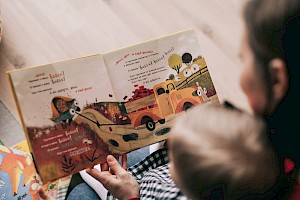 Having a sleep routine is so important to help children (and adults!) wind down after their day and get ready to sleep. Here are some ideas to help create a language-rich environment for children as they prepare for bed:
Having a sleep routine is so important to help children (and adults!) wind down after their day and get ready to sleep. Here are some ideas to help create a language-rich environment for children as they prepare for bed:
Vocabulary
Caregivers can help children develop their vocabulary by creating verbal routines. A verbal routine creates a predictable language script for children to become familiar with actions and objects. Here are some examples of verbal routines:
- In the bath: “wash was wash your feet, wash was wash your hands, wash wash wash your belly”
- Brushing teeth: “brush brush your top teeth, brush brush your bottom teeth, brush brush your teeth inside”
- Putting on pyjamas: “Left leg out, left leg in, right leg out, right leg in, pull, pull, pull, all done!”
Following instructions
During the bedtime routine, caregivers can help children to develop their listening and following instructions skills by:
- Breaking up long instructions into smaller parts (e.g. instead of “Grab your teddy and a book after you brush your teeth”, try: “Brush your teeth. Get your teddy. Get a book”). As children build their confidence and skills in following instructions, increase the number of steps that are provided.
Literacy
There’s nothing like a bedtime story before bed to wind down. Reading to children from a young age is so important to promote literacy and language development.
- Reading from a young age will help children practise early literacy skills of reading from left to right and turning pages
- Encourage children to point at pictures and repeat names of objects to associate pictures with real-world objects (e.g. DOG, that’s a DOG, just like our DOG, ____ (dog’s name))
- Choose books based on your child’s interests to help build interest and engagement in reading
- Reading books with rhymes (e.g. Dr. Seuss books) is a great way to introduce the concept of rhyme. Caregivers can draw attention to rhyming words by saying ‘cAT’ and ‘hAT’, did you notice those words sound the same sounds at the end? They both have ‘AT’ at the end”
- Help children blend sounds together to form words (e.g. c-a-r makes ___ or c-ar makes ____)
- Encourage children to read familiar words to build their confidence
- Ask children questions to promote reading comprehension (e.g. Who was in the story? What was the problem? What did they do? What do you think will happen next?)
Expressive language
Talking to children about their day or about the bedtime story is a great way to practise using language in a meaningful way. Caregivers can support children to sequence and elaborate on their answers by asking questions such as:
- What did you do after school?
- Who was your favourite character in the book? Why?
- Who did you play with at lunch?
Related Blog Posts
If you liked this post you may also like:
Sound Flowers
Welcome to 2017!
The importance of play
Phonological awareness



